 Technology peripherals
Technology peripherals
 AI
AI
 How to use reinforcement learning to improve Kuaishou user retention?
How to use reinforcement learning to improve Kuaishou user retention?
How to use reinforcement learning to improve Kuaishou user retention?
The core goal of the short video recommendation system is to drive DAU growth by improving user retention. Therefore, retention is one of the core business optimization indicators of each APP. However, retention is long-term feedback after multiple interactions between users and the system, and it is difficult to decompose it into a single item or a single list. Therefore, it is difficult for traditional point-wise and list-wise models to directly optimize retention.
The reinforcement learning (RL) method optimizes long-term rewards by interacting with the environment, and is suitable for directly optimizing user retention. This work models the retention optimization problem as a Markov decision process (MDP) with infinite horizon request granularity. Each time the user requests the recommendation system to decide an action, it is used to aggregate multiple different short-term feedback estimates (watch Duration, likes, attention, comments, retweets, etc.) ranking model scoring. The goal of this work is to learn policies, minimize the cumulative time interval between multiple user sessions, increase the frequency of app openings, and thereby increase user retention.
However, due to the characteristics of the retained signal, the direct application of existing RL algorithms has the following challenges: 1) Uncertainty: the retained signal is not only determined by the recommendation algorithm, but is also interfered by many external factors; 2) Bias: The retention signal has deviations in different time periods and user groups with different levels of activity; 3) Instability: Unlike game environments that return rewards immediately, retention signals usually return within hours to days, which will cause the RL algorithm to go online Training instability problem.
This work proposes the Reinforcement Learning for User Retention algorithm (RLUR) algorithm to solve the above challenges and directly optimize retention. Through offline and online verification, the RLUR algorithm can significantly improve the secondary retention index compared to the State of Art baseline. The RLUR algorithm has been fully implemented in the Kuaishou App and can continuously achieve significant secondary retention and DAU revenue. It is the first time in the industry that RL technology has been used to improve user retention in a real production environment. This work has been accepted into the WWW 2023 Industry Track.
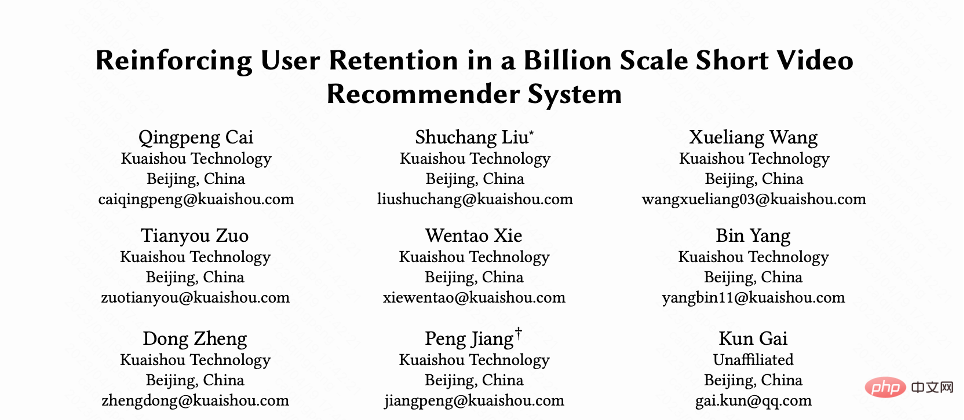
## Author: Cai Qingpeng, Liu Shuchang, Wang Xueliang, Zuo Tianyou, Xie Wentao, Yang Bin, Zheng Dong, Jiang Peng
Paper address: https://arxiv.org/pdf/2302.01724.pdf
Problem ModelingAs shown in Figure 1(a), this work models the retention optimization problem as an infinite horizon request-based Markov Decision Process, in which the recommendation system is agent, the user is the environment. Every time the user opens the App, a new session i is opened. As shown in Figure 1(b), each time the user requests  the recommendation system decides a parameter vector
the recommendation system decides a parameter vector  based on the user status
based on the user status  , while n A ranking model that estimates different short-term indicators (viewing time, likes, attention, etc.) scores each candidate video j
, while n A ranking model that estimates different short-term indicators (viewing time, likes, attention, etc.) scores each candidate video j . Then the sorting function inputs the action and the scoring vector of each video to obtain the final score of each video, and selects the 6 videos with the highest scores to display to the user, and the user returns immediate feedback
. Then the sorting function inputs the action and the scoring vector of each video to obtain the final score of each video, and selects the 6 videos with the highest scores to display to the user, and the user returns immediate feedback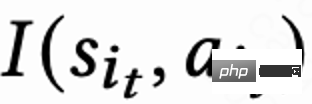 . When the user leaves the App, this session ends. The next time the user opens the App, session i 1 is opened. The time interval between the end of the previous session and the beginning of the next session is called return time (Returning time),
. When the user leaves the App, this session ends. The next time the user opens the App, session i 1 is opened. The time interval between the end of the previous session and the beginning of the next session is called return time (Returning time),  . The goal of this research is to train a strategy that minimizes the sum of callback times for multiple sessions.
. The goal of this research is to train a strategy that minimizes the sum of callback times for multiple sessions.
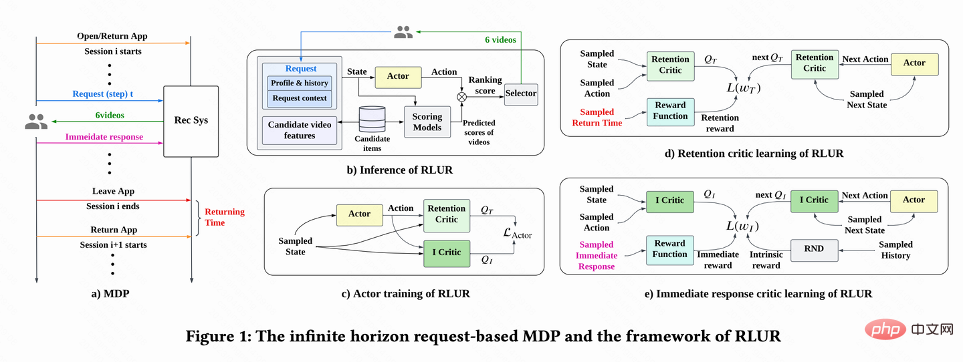
RLUR Algorithm
This work first discusses how to estimate the cumulative return visit time, and then proposes methods to solve several key challenges of retained signals. These methods are summarized into the Reinforcement Learning for User Retention algorithm, abbreviated as RLUR.
Estimation of return visit time
As shown in Figure 1(d), since the action is continuous, the The work adopts the temporal difference (TD) learning method of DDPG algorithm to estimate the return visit time.

Since only the last request of each session has a return visit time reward, and the intermediate reward is 0, the author sets the discount factor The value of the last request in each session is
The value of the last request in each session is  , and the value of other requests is 1. This setting can avoid the exponential decay of return visit time. And it can be theoretically proven that when loss (1) is 0, Q actually estimates the cumulative return time of multiple sessions,
, and the value of other requests is 1. This setting can avoid the exponential decay of return visit time. And it can be theoretically proven that when loss (1) is 0, Q actually estimates the cumulative return time of multiple sessions,  .
.
Solve the delayed reward problem
Since the return visit time only occurs at the end of each session , which will bring about the problem of low learning efficiency. The authors therefore use heuristic rewards to enhance policy learning. Since short-term feedback is positively related to retention, the author uses short-term feedback as the first heuristic reward. And the author adopts Random Network Distillation (RND) network to calculate the intrinsic reward of each sample as the second heuristic reward. Specifically, the RND network uses two identical network structures. One network is randomly initialized to fixed, and the other network fits the fixed network, and the fitting loss is used as an intrinsic reward. As shown in Figure 1(e), in order to reduce the interference of heuristic rewards on retention rewards, this work learns a separate critic network to estimate the sum of short-term feedback and intrinsic rewards. Right now  .
.
Solve the problem of uncertainty
Received many recommendations due to the time of return visit The uncertainty is high due to the influence of factors, which will affect the learning effect. This work proposes a regularization method to reduce variance: first estimate a classification model  to estimate the return visit time probability, that is, whether the estimated return visit time is shorter than
to estimate the return visit time probability, that is, whether the estimated return visit time is shorter than  ; Then use Markov's inequality to get the lower bound of the return visit time,
; Then use Markov's inequality to get the lower bound of the return visit time,  ; Finally, use the actual return visit time/estimated return visit time lower bound as the regularized return visit reward.
; Finally, use the actual return visit time/estimated return visit time lower bound as the regularized return visit reward.
Solve the bias problem
Due to the large differences in behavioral habits of different active groups, highly active users The retention rate is high and the number of training samples is significantly larger than that of low-active users, which will cause model learning to be dominated by high-active users. To solve this problem, this work learns 2 independent strategies for different groups of high activity and low activity, and uses different data streams for training. The Actor minimizes the return visit time while maximizing the auxiliary reward. As shown in Figure 1(c), taking the high-activity group as an example, the Actor loss is:

Solving the instability problem
Due to the signal delay in return visit time, Generally returns within a few hours to days, which can lead to instability in RL online training. Directly using existing behavior cloning methods either greatly limits the learning speed or cannot guarantee stable learning. Therefore, this work proposes a new soft regularization method, that is, multiplying the actor loss by a soft regularization coefficient:

This regularization method is essentially a braking effect: if the current learning strategy and the sample strategy deviate greatly, the loss will become smaller and the learning will tend to be stable; if the learning speed tends to be stable, the loss will re- The bigger you get, the faster you learn. When  , it means there is no restriction on the learning process.
, it means there is no restriction on the learning process.
Offline experiment
This work combines RLUR and State of the Art’s reinforcement learning algorithm TD3, as well as the black-box optimization method Cross Entropy Method (CEM) in The public data set KuaiRand is used for comparison. This work first builds a retention simulator based on the KuaiRand data set: including three modules: user immediate feedback, user leaving the session, and user return visit to the app, and then evaluating the retention simulator method.
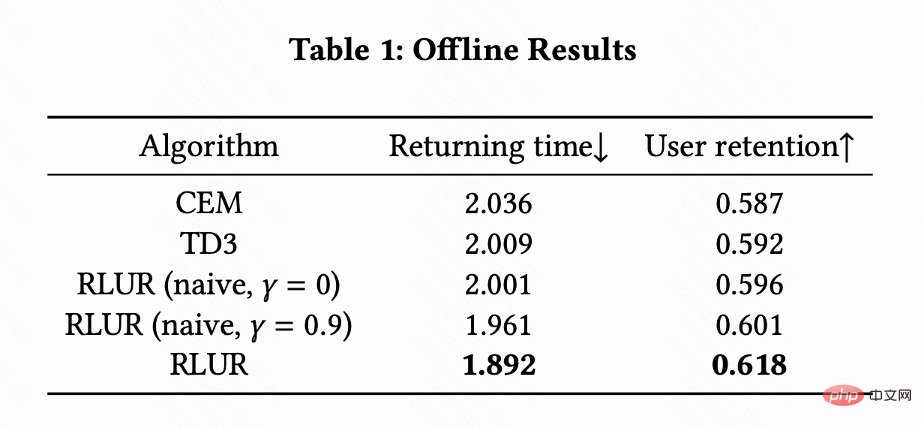
Table 1 illustrates that RLUR is significantly better than CEM and TD3 in terms of return visit time and secondary retention indicators. This study conducts ablation experiments to compare RLUR with only the retention learning part (RLUR (naive)), which can illustrate the effectiveness of this study's approach to solving retention challenges. And through the comparison of  and
and  , it is shown that the algorithm of minimizing the return visit time of multiple sessions is better than minimizing the return visit time of a single session.
, it is shown that the algorithm of minimizing the return visit time of multiple sessions is better than minimizing the return visit time of a single session.
Online experiment
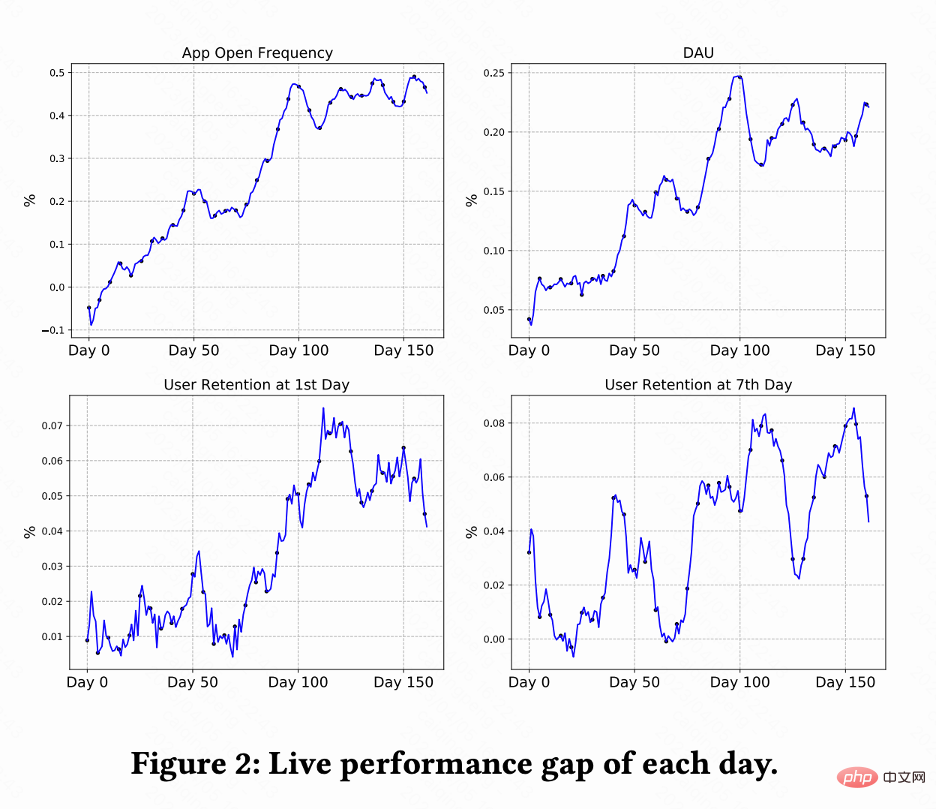
This work conducts A/B testing on the Kuaishou short video recommendation system to compare the RLUR and CEM methods . Figure 2 shows the improvement percentages of app opening frequency, DAU, first retention, and 7th retention compared to RLUR and CEM respectively. It can be found that the frequency of app opening gradually increases and even converges from 0 to 100 days. And it also drives the improvement of the second retention, 7th retention and DAU indicators (a 0.1% DAU and 0.01% improvement in second retention are considered statistically significant).
Summary and future work
This paper studies how to improve user retention of recommendation systems through RL technology. This work models retention optimization as a Marko with infinite horizon request granularity. This work proposes the RLUR algorithm to directly optimize retention and effectively address several key challenges of retention signals. The RLUR algorithm has been fully implemented in Kuaishou App and can achieve significant secondary retention and DAU revenue. Regarding future work, how to use offline reinforcement learning, Decision Transformer and other methods to more effectively improve user retention is a promising direction.
The above is the detailed content of How to use reinforcement learning to improve Kuaishou user retention?. For more information, please follow other related articles on the PHP Chinese website!

Hot AI Tools

Undresser.AI Undress
AI-powered app for creating realistic nude photos

AI Clothes Remover
Online AI tool for removing clothes from photos.

Undress AI Tool
Undress images for free

Clothoff.io
AI clothes remover

AI Hentai Generator
Generate AI Hentai for free.

Hot Article

Hot Tools

Notepad++7.3.1
Easy-to-use and free code editor

SublimeText3 Chinese version
Chinese version, very easy to use

Zend Studio 13.0.1
Powerful PHP integrated development environment

Dreamweaver CS6
Visual web development tools

SublimeText3 Mac version
God-level code editing software (SublimeText3)

Hot Topics
 CLIP-BEVFormer: Explicitly supervise the BEVFormer structure to improve long-tail detection performance
Mar 26, 2024 pm 12:41 PM
CLIP-BEVFormer: Explicitly supervise the BEVFormer structure to improve long-tail detection performance
Mar 26, 2024 pm 12:41 PM
Written above & the author’s personal understanding: At present, in the entire autonomous driving system, the perception module plays a vital role. The autonomous vehicle driving on the road can only obtain accurate perception results through the perception module. The downstream regulation and control module in the autonomous driving system makes timely and correct judgments and behavioral decisions. Currently, cars with autonomous driving functions are usually equipped with a variety of data information sensors including surround-view camera sensors, lidar sensors, and millimeter-wave radar sensors to collect information in different modalities to achieve accurate perception tasks. The BEV perception algorithm based on pure vision is favored by the industry because of its low hardware cost and easy deployment, and its output results can be easily applied to various downstream tasks.
 Implementing Machine Learning Algorithms in C++: Common Challenges and Solutions
Jun 03, 2024 pm 01:25 PM
Implementing Machine Learning Algorithms in C++: Common Challenges and Solutions
Jun 03, 2024 pm 01:25 PM
Common challenges faced by machine learning algorithms in C++ include memory management, multi-threading, performance optimization, and maintainability. Solutions include using smart pointers, modern threading libraries, SIMD instructions and third-party libraries, as well as following coding style guidelines and using automation tools. Practical cases show how to use the Eigen library to implement linear regression algorithms, effectively manage memory and use high-performance matrix operations.
 Deep Q-learning reinforcement learning using Panda-Gym's robotic arm simulation
Oct 31, 2023 pm 05:57 PM
Deep Q-learning reinforcement learning using Panda-Gym's robotic arm simulation
Oct 31, 2023 pm 05:57 PM
Reinforcement learning (RL) is a machine learning method that allows an agent to learn how to behave in its environment through trial and error. Agents are rewarded or punished for taking actions that lead to desired outcomes. Over time, the agent learns to take actions that maximize its expected reward. RL agents are typically trained using a Markov decision process (MDP), a mathematical framework for modeling sequential decision problems. MDP consists of four parts: State: a set of possible states of the environment. Action: A set of actions that an agent can take. Transition function: A function that predicts the probability of transitioning to a new state given the current state and action. Reward function: A function that assigns a reward to the agent for each conversion. The agent's goal is to learn a policy function,
 Explore the underlying principles and algorithm selection of the C++sort function
Apr 02, 2024 pm 05:36 PM
Explore the underlying principles and algorithm selection of the C++sort function
Apr 02, 2024 pm 05:36 PM
The bottom layer of the C++sort function uses merge sort, its complexity is O(nlogn), and provides different sorting algorithm choices, including quick sort, heap sort and stable sort.
 Can artificial intelligence predict crime? Explore CrimeGPT's capabilities
Mar 22, 2024 pm 10:10 PM
Can artificial intelligence predict crime? Explore CrimeGPT's capabilities
Mar 22, 2024 pm 10:10 PM
The convergence of artificial intelligence (AI) and law enforcement opens up new possibilities for crime prevention and detection. The predictive capabilities of artificial intelligence are widely used in systems such as CrimeGPT (Crime Prediction Technology) to predict criminal activities. This article explores the potential of artificial intelligence in crime prediction, its current applications, the challenges it faces, and the possible ethical implications of the technology. Artificial Intelligence and Crime Prediction: The Basics CrimeGPT uses machine learning algorithms to analyze large data sets, identifying patterns that can predict where and when crimes are likely to occur. These data sets include historical crime statistics, demographic information, economic indicators, weather patterns, and more. By identifying trends that human analysts might miss, artificial intelligence can empower law enforcement agencies
 Improved detection algorithm: for target detection in high-resolution optical remote sensing images
Jun 06, 2024 pm 12:33 PM
Improved detection algorithm: for target detection in high-resolution optical remote sensing images
Jun 06, 2024 pm 12:33 PM
01 Outlook Summary Currently, it is difficult to achieve an appropriate balance between detection efficiency and detection results. We have developed an enhanced YOLOv5 algorithm for target detection in high-resolution optical remote sensing images, using multi-layer feature pyramids, multi-detection head strategies and hybrid attention modules to improve the effect of the target detection network in optical remote sensing images. According to the SIMD data set, the mAP of the new algorithm is 2.2% better than YOLOv5 and 8.48% better than YOLOX, achieving a better balance between detection results and speed. 02 Background & Motivation With the rapid development of remote sensing technology, high-resolution optical remote sensing images have been used to describe many objects on the earth’s surface, including aircraft, cars, buildings, etc. Object detection in the interpretation of remote sensing images
 Learn to assemble a circuit board in 20 minutes! The open source SERL framework has a 100% precision control success rate and is three times faster than humans
Feb 21, 2024 pm 03:31 PM
Learn to assemble a circuit board in 20 minutes! The open source SERL framework has a 100% precision control success rate and is three times faster than humans
Feb 21, 2024 pm 03:31 PM
Now, robots can learn precision factory control tasks. In recent years, significant progress has been made in the field of robot reinforcement learning technology, such as quadruped walking, grasping, dexterous manipulation, etc., but most of them are limited to the laboratory demonstration stage. Widely applying robot reinforcement learning technology to actual production environments still faces many challenges, which to a certain extent limits its application scope in real scenarios. In the process of practical application of reinforcement learning technology, it is necessary to overcome multiple complex problems including reward mechanism setting, environment reset, sample efficiency improvement, and action safety guarantee. Industry experts emphasize that solving the many problems in the actual implementation of reinforcement learning technology is as important as the continuous innovation of the algorithm itself. Faced with this challenge, researchers from the University of California, Berkeley, Stanford University, the University of Washington, and
 Application of algorithms in the construction of 58 portrait platform
May 09, 2024 am 09:01 AM
Application of algorithms in the construction of 58 portrait platform
May 09, 2024 am 09:01 AM
1. Background of the Construction of 58 Portraits Platform First of all, I would like to share with you the background of the construction of the 58 Portrait Platform. 1. The traditional thinking of the traditional profiling platform is no longer enough. Building a user profiling platform relies on data warehouse modeling capabilities to integrate data from multiple business lines to build accurate user portraits; it also requires data mining to understand user behavior, interests and needs, and provide algorithms. side capabilities; finally, it also needs to have data platform capabilities to efficiently store, query and share user profile data and provide profile services. The main difference between a self-built business profiling platform and a middle-office profiling platform is that the self-built profiling platform serves a single business line and can be customized on demand; the mid-office platform serves multiple business lines, has complex modeling, and provides more general capabilities. 2.58 User portraits of the background of Zhongtai portrait construction





